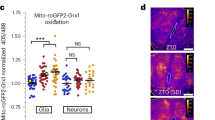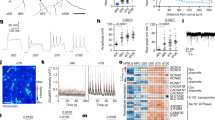Abstract
Polyamines are endogenous molecules involved in cell damage following neurological insults, although it is unclear whether polyamines reduce or exacerbate this damage. We used a developmental seizure model in which we exposed Xenopus laevis tadpoles to pentylenetetrazole (PTZ), a known convulsant. We found that, after an initial PTZ exposure, seizure onset times were delayed in response to a second PTZ exposure 4 h later. This protective effect was a result of activity-dependent increases in synthesis of putrescine, the simplest polyamine. Unlike more complex polyamines that directly modulate ion channels, putrescine exerted its effect by altering the balance of excitation to inhibition. Tectal neuron recordings, 4 h after the initial seizure, revealed an elevated frequency of GABAergic spontaneous inhibitory postsynaptic currents. Our data suggest that this effect is mediated by an atypical pathway that converts putrescine into GABA, which then activates presynaptic GABAB receptors. Our data suggest that polyamines have a previously unknown neuroprotective role in the developing brain.
This is a preview of subscription content, access via your institution
Access options
Subscribe to this journal
Receive 12 print issues and online access
$209.00 per year
only $17.42 per issue
Buy this article
- Purchase on Springer Link
- Instant access to full article PDF
Prices may be subject to local taxes which are calculated during checkout








Similar content being viewed by others
References
Cowan, L.D. The epidemiology of the epilepsies in children. Ment. Retard. Dev. Disabil. Res. Rev. 8, 171–181 (2002).
Scharfman, H.E. The neurobiology of epilepsy. Curr. Neurol. Neurosci. Rep. 7, 348–354 (2007).
Williams, K. Interactions of polyamines with ion channels. Biochem. J. 325, 289–297 (1997).
Tabor, C.W. & Tabor, H. Polyamines. Annu. Rev. Biochem. 53, 749–790 (1984).
Lerma, J. Spermine regulates N-methyl-D-aspartate receptor desensitization. Neuron 8, 343–352 (1992).
Williams, K. Modulation and block of ion channels: a new biology of polyamines. Cell. Signal. 9, 1–13 (1997).
Osawa, M. et al. Evidence for the direct interaction of spermine with inwardly rectifying potassium channel. J. Biol. Chem. 284, 26117–26126 (2009).
Bowie, D. & Mayer, M.L. Inward rectification of both AMPA and kainate subtype glutamate receptors generated by polyamine-mediated ion channel block. Neuron 15, 453–462 (1995).
Zawia, N.H. & Bondy, S.C. Electrically stimulated rapid gene expression in the brain: ornithine decarboxylase and c-fos. Brain Res. Mol. Brain Res. 7, 243–247 (1990).
Pegg, A.E. Regulation of ornithine decarboxylase. J. Biol. Chem. 281, 14529–14532 (2006).
Gilad, G.M. & Gilad, V.H. Polyamine biosynthesis is required for survival of sympathetic neurons after axonal injury. Brain Res. 273, 191–194 (1983).
Aizenman, C.D., Munoz-Elias, G. & Cline, H.T. Visually driven modulation of glutamatergic synaptic transmission is mediated by the regulation of intracellular polyamines. Neuron 34, 623–634 (2002).
Shin, J., Shen, F. & Huguenard, J. PKC and polyamine modulation of GluR2-deficient AMPA receptors in immature neocortical pyramidal neurons of the rat. J. Physiol. (Lond.) 581, 679–691 (2007).
Hayashi, Y., Hattori, Y., Moriwaki, A., Lu, Y.F. & Hori, Y. Increases in brain polyamine concentrations in chemical kindling and single convulsion induced by pentylenetetrazol in rats. Neurosci. Lett. 149, 63–66 (1993).
Camón, L., de Vera, N. & Martinez, E. Polyamine metabolism and glutamate receptor agonists-mediated excitotoxicity in the rat brain. J. Neurosci. Res. 66, 1101–1111 (2001).
de Vera, N., Camon, L. & Martinez, E. Cerebral distribution of polyamines in kainic acid–induced models of status epilepticus and ataxia in rats. Overproduction of putrescine and histological damage. Eur. Neuropsychopharmacol. 12, 397–405 (2002).
Najm, I. et al. Seizure activity-induced changes in polyamine metabolism and neuronal pathology during the postnatal period in rat brain. Brain Res. Dev. Brain Res. 69, 11–21 (1992).
Paschen, W. Polyamine metabolism in different pathological states of the brain. Mol. Chem. Neuropathol. 16, 241–271 (1992).
de Vera, N., Martinez, E. & Sanfeliu, C. Spermine induces cell death in cultured human embryonic cerebral cortical neurons through N-methyl-D-aspartate receptor activation. J. Neurosci. Res. 86, 861–872 (2008).
Halonen, T. et al. Elevated seizure threshold and impaired spatial learning in transgenic mice with putrescine overproduction in the brain. Eur. J. Neurosci. 5, 1233–1239 (1993).
Shimosato, K., Watanabe, S., Marley, R.J. & Saito, T. Increased polyamine levels and changes in the sensitivity to convulsions during chronic treatment with cocaine in mice. Brain Res. 684, 243–247 (1995).
Kaasinen, S.K., Grohn, O.H., Keinanen, T.A., Alhonen, L. & Janne, J. Overexpression of spermidine/spermine N1-acetyltransferase elevates the threshold to pentylenetetrazol-induced seizure activity in transgenic mice. Exp. Neurol. 183, 645–652 (2003).
Baraban, S.C., Taylor, M.R., Castro, P.A. & Baier, H. Pentylenetetrazole induced changes in zebrafish behavior, neural activity and c-fos expression. Neuroscience 131, 759–768 (2005).
Hewapathirane, D.S. & Haas, K. Single cell electroporation in vivo within the intact developing brain. J. Vis. Exp. published online, doi:10.3791/705 (11 July 2008).
Aizenman, C.D., Akerman, C.J., Jensen, K.R. & Cline, H.T. Visually driven regulation of intrinsic neuronal excitability improves stimulus detection in vivo. Neuron 39, 831–842 (2003).
Fleidervish, I.A., Libman, L., Katz, E. & Gutnick, M.J. Endogenous polyamines regulate cortical neuronal excitability by blocking voltage-gated Na+ channels. Proc. Natl. Acad. Sci. USA 105, 18994–18999 (2008).
Akerman, C.J. & Cline, H.T. Depolarizing GABAergic conductances regulate the balance of excitation to inhibition in the developing retinotectal circuit in vivo. J. Neurosci. 26, 5117–5130 (2006).
Sequerra, E.B., Gardino, P., Hedin-Pereira, C. & de Mello, F.G. Putrescine as an important source of GABA in the postnatal rat subventricular zone. Neuroscience 146, 489–493 (2007).
Noto, T., Hashimoto, H., Nakao, J., Kamimura, H. & Nakajima, T. Spontaneous release of gamma-aminobutyric acid formed from putrescine and its enhanced Ca2+-dependent release by high K+ stimulation in the brains of freely moving rats. J. Neurochem. 46, 1877–1880 (1986).
Yamasaki, E.N., Barbosa, V.D., De Mello, F.G. & Hokoc, J.N. GABAergic system in the developing mammalian retina: dual sources of GABA at early stages of postnatal development. Int. J. Dev. Neurosci. 17, 201–213 (1999).
Laschet, J., Grisar, T., Bureau, M. & Guillaume, D. Characteristics of putrescine uptake and subsequent GABA formation in primary cultured astrocytes from normal C57BL/6J and epileptic DBA/2J mouse brain cortices. Neuroscience 48, 151–157 (1992).
Seiler, N. Catabolism of polyamines. Amino Acids 26, 217–233 (2004).
Seiler, N. & Al-Therib, M.J. Putrescine catabolism in mammalian brain. Biochem. J. 144, 29–35 (1974).
Pitler, T.A. & Alger, B.E. Differences between presynaptic and postsynaptic GABAB mechanisms in rat hippocampal pyramidal cells. J. Neurophysiol. 72, 2317–2327 (1994).
Pitler, T.A. & Alger, B.E. Depolarization-induced suppression of GABAergic inhibition in rat hippocampal pyramidal cells: G protein involvement in a presynaptic mechanism. Neuron 13, 1447–1455 (1994).
Pearce, R.A., Grunder, S.D. & Faucher, L.D. Different mechanisms for use-dependent depression of two GABAA-mediated IPSCs in rat hippocampus. J. Physiol. (Lond.) 484, 425–435 (1995).
Haas, K.Z., Sperber, E.F., Moshe, S.L. & Stanton, P.K. Kainic acid-induced seizures enhance dentate gyrus inhibition by downregulation of GABA(B) receptors. J. Neurosci. 16, 4250–4260 (1996).
Hayashi, Y., Hattori, Y. & Hori, Y. Involvement of putrescine in the development of kindled seizure in rats. J. Neurochem. 58, 562–566 (1992).
Schousboe, A. Pharmacological and functional characterization of astrocytic GABA transport: a short review. Neurochem. Res. 25, 1241–1244 (2000).
Haas, K.Z., Sperber, E.F., Opanashuk, L.A., Stanton, P.K. & Moshe, S.L. Resistance of immature hippocampus to morphologic and physiologic alterations following status epilepticus or kindling. Hippocampus 11, 615–625 (2001).
Liu, Z. et al. Consequences of recurrent seizures during early brain development. Neuroscience 92, 1443–1454 (1999).
Zawia, N.H. & Harry, G.J. Correlations between developmental ornithine decarboxylase gene expression and enzyme activity in the rat brain. Brain Res. Dev. Brain Res. 71, 53–57 (1993).
Shin, J., Shen, F. & Huguenard, J.R. Polyamines modulate AMPA receptor-dependent synaptic responses in immature layer V pyramidal neurons. J. Neurophysiol. 93, 2634–2643 (2005).
Sankar, R., Shin, D.H. & Wasterlain, C.G. GABA metabolism during status epilepticus in the developing rat brain. Brain Res. Dev. Brain Res. 98, 60–64 (1997).
Nieuwkoop, P.D. & Faber, J. Normal Table of Xenopus laevis (Daudin) (Garland Publishing, New York, 1956).
Wu, G., Malinow, R. & Cline, H.T. Maturation of a central glutamatergic synapse. Science 274, 972–976 (1996).
Pratt, K.G. & Aizenman, C.D. Homeostatic regulation of intrinsic excitability and synaptic transmission in a developing visual circuit. J. Neurosci. 27, 8268–8277 (2007).
Clements, J.D. & Bekkers, J.M. Detection of spontaneous synaptic events with an optimally scaled template. Biophys. J. 73, 220–229 (1997).
Kamboj, S.K., Swanson, G.T. & Cull-Candy, S.G. Intracellular spermine confers rectification on rat calcium-permeable AMPA and kainate receptors. J. Physiol. (Lond.) 486, 297–303 (1995).
Acknowledgements
We would like to thank B. Connors and J. Kauer with helpful discussion and suggestions to the manuscript. We also thank I. Sears, B. Clarkson and E. Stackpole for technical support and J. Lippman Bell for editorial support. This work was supported by the American Heart Association and the US National Institutes of Health. C.D.A. was also supported by the Klingenstein Fund, M.R.B. by a Graduate Research Fellowship Program award from the National Science Foundation, J.A.B. by a Brain Science Siravo Award for Epilepsy Research and H.F.J. by a Brown University Undergraduate Teaching and Research Award.
Author information
Authors and Affiliations
Contributions
M.R.B. conducted the experiments and wrote the manuscript. J.A.B. contributed to the behavioral testing. H.F.J. contributed to the behavioral testing and the ELISA. C.D.A. supervised the project and edited the manuscript.
Corresponding author
Ethics declarations
Competing interests
The authors declare no competing financial interests.
Supplementary information
Supplementary Text and Figures
Supplementary Figures 1–3 (PDF 162 kb)
Supplementary Movie 1
Xenopus tapole induced PTZ seizures. (MOV 4731 kb)
Rights and permissions
About this article
Cite this article
Bell, M., Belarde, J., Johnson, H. et al. A neuroprotective role for polyamines in a Xenopus tadpole model of epilepsy. Nat Neurosci 14, 505–512 (2011). https://doi.org/10.1038/nn.2777
Received:
Accepted:
Published:
Issue Date:
DOI: https://doi.org/10.1038/nn.2777
This article is cited by
-
Can peri-ovulatory putrescine supplementation improve egg quality in older infertile women?
Journal of Assisted Reproduction and Genetics (2019)
-
Fragile X mental retardation protein knockdown in the developing Xenopus tadpole optic tectum results in enhanced feedforward inhibition and behavioral deficits
Neural Development (2016)
-
Spermidine promotes retinal ganglion cell survival and optic nerve regeneration in adult mice following optic nerve injury
Cell Death & Disease (2015)
-
Animal models in epilepsy research: legacies and new directions
Nature Neuroscience (2015)
-
Finding Order in Human Neurological Disorder Using a Tadpole
Current Pathobiology Reports (2015)



